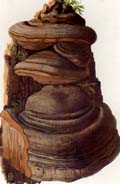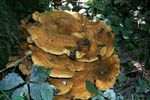 Key to Gilled Mushrooms Key
Key to Gilled Mushrooms KeyThis is a key to gilled mushrooms, that is, mushrooms having a definite cap with a fertile surface consisting of gills. The fruiting body usually also has a stem, although that may be lateral or absent (usually, then, the mushroom is growing from wood). You can use this key to identify mushrooms that you find.
 Polyporaceae Family
Polyporaceae FamilyFertile surface usually a layer of vertical tubes, of which the mouths are visible as pores on the underside of the cap or shelf.
Fruiting bodies usually tougher or harder than the "normal" gilled mushrooms, being leathery, corky, or woody. But they can be quite tender while actively growing
Once grown, they do not decay easily, remaining on the substrate for months or years
They often grow on wood, although a few are terrestrial (even those are usually growing on buried wood)
Fruiting body is usually a flat shelf, or hoof-shaped, protruding directly from the substrate, although sometimes it may have a short stalk.
Some forms never grow away from the substrate at all, so that all that is visible of the fruiting body are the pores.
Sometimes the pores are so minute that the fertile surface seems solid, until you look closely
 Terrestriopolypore Subfamily
Terrestriopolypore SubfamilyGrowing on ground
 Big Terrestriopolypore Tribe
Big Terrestriopolypore TribeLarge (6-18" or more across), compound fruiting body with irregular caps, usually right next to a tree or even surrounding it
Flesh flexible, tough but not hard
 Fewocappus Subtribe
Fewocappus SubtribeFruiting body composed of a few large caps, each larger than a three or four inches across
Bondarzewia Genus Singer

Diagnosis
- Pores creamy.
-
Caps creamy tan to brown, with yellow mixed in
-
Usually occurring at the base of hardwoods

Comments
The type species for the genus, Bondarzewia montana, occurs at the base of conifers. It has not yet been reported East of the Rocky Mountains, but could appear with transplanted trees
Narrow down your identification:
 Bondarzewia berkeleyi
Bondarzewia berkeleyiAt the base of hardwoods, especially oaks; acquires a disgusting odor in old age






 Key to Gilled Mushrooms Key
Key to Gilled Mushrooms Key Polyporaceae Family
Polyporaceae Family Big Terrestriopolypore Tribe
Big Terrestriopolypore Tribe Fewocappus Subtribe
Fewocappus Subtribe





